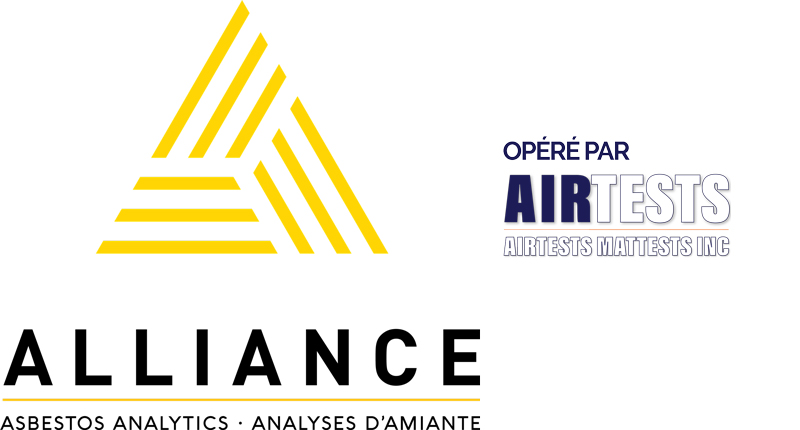Asbestos, tests and methods?

The preferred way to identify contaminated flocking and insulation is through a building inspection.
Subsequently, several recognized methods can be used to detect and characterize asbestos. It is important to keep in mind that the methods are adapted according to the case.
IRSST 244-3 METHOD (MLP)
MINERALOGICAL CHARACTERIZATION IN POLARIZING MICROSCOPY AND COLOR DISPERSION
The samples were lightly crushed mechanically, which allows extracting the asbestos fibers. Subsequently, the collected particles and fibers are transferred onto slides and covered with a coverslip. The experts then dip the slides into suitable refractive index liquids to be able to observe the color dispersion of the samples. Other properties may come into play to complete the characterization (optical, conoscopic and orthoscopic properties).
IRSST 243-1 METHOD (MOCP)
PHASE CONTRAST OPTICAL MICROSCOPY
This type of method determines the exposure index when the most important type of fiber in the air is asbestos. The test is carried out using a conductive cassette with an extension equipped with a membrane of mixed cellulose esters (ECM). The flow rate can be modified to collect a sample of a weighted average value for measuring in environments where there is only very little dust, the concentration of fibers.
ELAP 198.4 (MET) METHOD
MINERALOGICAL CHARACTERIZATION BY TRANSMISSION ELECTRON MICROSCOPY
The identification and quantification of asbestos taken from non-friable bulk samples bound by organic materials are analyzed by transmission electron microscopy. These analyses are performed using the FEI Tecnai Twin TEM as well as EDAX Genesis System using EDXA, the X-ray energy dispersion analysis.
Some materials likely to contain asbestos
As for the characterization of MSCA (materials likely to contain asbestos), tests can be carried out to perform the counting of asbestos fibers in the air and this, in various fields.

Buildings
Industrial, Commercial

Equipment
ndustrial, Heavy Machineries

Industries
Maritime, Rail, Air
Sampling of fibers in suspension in air on job sites
IRSST 244-3 METHOD (MLP)
Determine the composition of minerals by polarizing microscopy and color dispersion.
IRSST 243-1 METHOD (MOCP)
Phase-contrast optical microscopy, which provides a good index of workplace exposure when asbestos is predominant.
ELAP Method 198.4 (MET)
Determine the composition of minerals by transmission electron microscopy to identify and quantify asbestos.
Information about asbestos-containing materials in the register must be updated at least once a year. Previous versions must be archived for a period of at least 30 years
- EPA (Environmental Protection Agency)
- IRSST (Institut Robert Sauvé en Santé et Sécurité au Travail)
- CNESST (Commission des normes, de l’équité, de la santé et de la sécurité du travail)
- Characterization service for materials that may contain asbestos in commercial, industrial and institutional buildings
- Material characterization service that can contain asbestos for industrial equipment and heavy machinery
- Material characterization service that can contain asbestos for the maritime, rail and air industries
- Asbestos fiber sampling and counting service suspension in the air on construction sites and final tests of conformity
- Asbestos sampling and analysis service contained in flocking and heat insulating/insulating and thermal barriers
- Sampling and analysis service for materials containing and likely to contain asbestos fibers / MCA and MSCA
Several other services are offered by Alliance to complete your request:
-
Sampling and analysis of asbestos tests required by legislation
• Collection and analysis of air tests before, during and after asbestos removal
• Sampling of insulating materials in specific areas
• Sampling of insulating materials, including vermiculite
• Approved laboratory analysis of bulk MSCA / MCA
• Inventory system for hazardous materials on an open spreadsheet
• Writing of characterization reports with recommendations
• Writing of asbestos management programs
• Customized training of workers and professionals
• Daily monitoring of asbestos removal work
• Checking the tightness of asbestos containment walls
• Report and Register on the safe management of asbestos
• Characterization of materials likely to contain asbestos
Characterization of buildings:
-
For Materials Suspected of Containing Asbestos (MSCA)
-
For Materials Containing Asbestos (MCA)
-
For flocking and heat insulating;For demolition (+ Pb, Hg, PBC)
-
For renovations by zones (partial).
-
